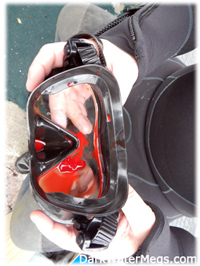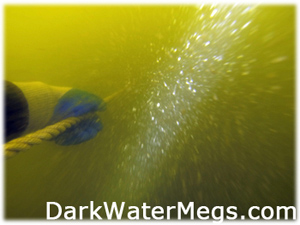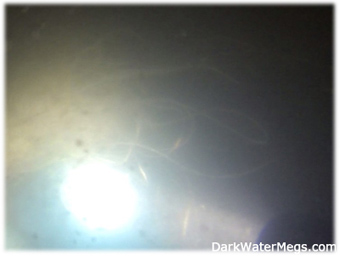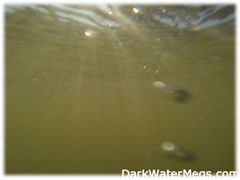Isn't darkwater diving for those megalodon teeth dangerous?
Scuba diving in high current for megalodon teeth is dangers
Scuba diving in Southeastern rivers for teeth is dangerous
"Isn't darkwater diving for those megalodon teeth dangerous?"
One of the most frequent questions I get asked is "isn't that dangerous?"

The answer is yes, there are some dangers associated with darkwater diving for megalodon teeth. It is important to keep in mind several factors though. First off everything has some level of danger, there is a chance that a meteor could hit my house while I am in it and kill me, a plan could crash and land on me while I am in my yard, or I could get in a car accident driving to the river to look for megalodon teeth. All of that being said there are some risks associated with darkwater diving, especially for megalodon teeth that increase the risk of injury or death when compared to normal everyday life.
Being underwater: The moment you dive into water, with or without SCUBA there is an increased risk, the reason for this is we humans cannot breath water, that means we need to take air with us either in a breath hold, piped down to us via a
hookah system, or with a system like SCUBA. Scuba diving is generally considered a safe sport when you have the proper training, correct equipment, and the environment you are in is within your skill set. The problem with dark water diving for megalodon shark teeth and other fossils is that very often the environment you are in is not ideal from a safety
standpoint and there are elevated risks due to the type of water you are in.
 current on the other hand can be inconvenient or dangerous. When darkwater diving for megalodon teeth we often find ourselves in 30-90 feet of water, the increased current can make ascending and descending more dangerous. During the descent you typically go down the anchor line, or a dock/pier piling. Heavy current can make it difficult to hold on and can cause a dangerous situation if the anchor breaks free of the bottom and sends you, the anchor, and the rope tumbling along the river bottom being pulled by the boat. Heavy current can also cause fatigue, often we work through heavy current by using spikes to get purchase on the bottom of the river bed, working and heavily breathing at depth can increase the nitrogen absorbed into your bloodstream as a result of breathing compressed air at depth and lead to problems. Heavy current can also make it difficult to catch the boat after ascending, cause entanglement in lines and nets on the bottom, and cause logs/crab traps/large mud balls to become dislodged and bounce along the bottom of the river, possibly entangling or impacting you as a diver.
current on the other hand can be inconvenient or dangerous. When darkwater diving for megalodon teeth we often find ourselves in 30-90 feet of water, the increased current can make ascending and descending more dangerous. During the descent you typically go down the anchor line, or a dock/pier piling. Heavy current can make it difficult to hold on and can cause a dangerous situation if the anchor breaks free of the bottom and sends you, the anchor, and the rope tumbling along the river bottom being pulled by the boat. Heavy current can also cause fatigue, often we work through heavy current by using spikes to get purchase on the bottom of the river bed, working and heavily breathing at depth can increase the nitrogen absorbed into your bloodstream as a result of breathing compressed air at depth and lead to problems. Heavy current can also make it difficult to catch the boat after ascending, cause entanglement in lines and nets on the bottom, and cause logs/crab traps/large mud balls to become dislodged and bounce along the bottom of the river, possibly entangling or impacting you as a diver.
Visibility: As highlighted in the article "Just how dark is it down there?" there is often little to no visibility in these rivers. That means it is difficult to read gauges, impossible to see other divers making buddy diving virtually impossible, you cannot see hazards before you swim into them, etc.
Missing the Boat / Dock / Shore Launch: While diving in the river you almost always go against the current, or up current. This is done so when you surface you are swept downstream towards your entry/exit  point by the current and can swim left or right to make sure to catch the boat or entry point. The problem arises when the current is strong, the tide switches, or you were not able to work far enough upstream during your dive. There is the possibility of surfacing with or without a megalodon tooth in your bag and parallel to the boat while being swept down current. For this reason many
darkwater megalodon divers use a tag line, or a rope attached to a float that is let out behind the boat to give the diver an extra 50-100' to catch the line and then pull themselves to the boat. Missing the boat can cause all kinds of problems, being swept out to sea, or being swept down river in very remote areas and not being able to get back to the boat.
point by the current and can swim left or right to make sure to catch the boat or entry point. The problem arises when the current is strong, the tide switches, or you were not able to work far enough upstream during your dive. There is the possibility of surfacing with or without a megalodon tooth in your bag and parallel to the boat while being swept down current. For this reason many
darkwater megalodon divers use a tag line, or a rope attached to a float that is let out behind the boat to give the diver an extra 50-100' to catch the line and then pull themselves to the boat. Missing the boat can cause all kinds of problems, being swept out to sea, or being swept down river in very remote areas and not being able to get back to the boat.
Low to no Visibility: As referenced in the article "Just how dark is it down there" low visibility is one of the reasons darkwater diving for megalodon teeth is dangerous. The reduced visibility makes it more difficult to read gauges, avoid underwater hazards, and makes buddy diving almost impossible. Along with current low or no visibility compounds all of the other dangers associated with darkwater diving for megalodon teeth.
Entanglement / Entrapment: One of the more serious hazards associated with darkwater diving for megalodon teeth is entanglement. The reason this can be so dangerous is lines, nets, cables, etc can trap the diver underwater. If trapped underwater without sufficient time or resources to free yourself it can cause a diver to run out of air and drown underwater. The reason entanglement is one of the top dangers darkwater diving for megalodon teeth is in high current and low visibility you often do not know that there is a tangled shrimp net, ball of fishing line, or tangle of construction cable until you have made contact with it and become stuck.
A diver looking for megalodon teeth can also become trapped or stuck in logs, underwater caves, or overhangs. Many times logs and trees fall into the rivers were we look for megalodon teeth, often these logs will snag on one another and become a tangled mess of logs and branches that can entrap and entangle a diver. One of my first darkwater dives I encountered such a situation. I was diving with my wife and we locked arms in an attempt  to buddy dive after being separated on an earlier dive that day in dark water. Suddenly she stopped moving and pulled me towards here, after a few seconds of failed hand signals she wrote out on her slate "stuck" and pointed behind her. I groped around in the dark until I realized her tank hand become lodged between two trees that we had unknowingly swam underneath, it took me about a minute to work the wedged tank out from the trees in the zero visibility but it felt like an hour.
to buddy dive after being separated on an earlier dive that day in dark water. Suddenly she stopped moving and pulled me towards here, after a few seconds of failed hand signals she wrote out on her slate "stuck" and pointed behind her. I groped around in the dark until I realized her tank hand become lodged between two trees that we had unknowingly swam underneath, it took me about a minute to work the wedged tank out from the trees in the zero visibility but it felt like an hour.
Underwater caves and overhangs are also a possible way to become entrapped, strong currents can cut into banks and soft bottoms of rivers making tunnels, caves, and overhangs. Often you do not realize you are in one until you bump your head on the roof, run into a dead end, or realize something is wrong when the current changes dramatically. I always try to avoid these caves and overhangs but often when you can only see 6-10inches or less it is impossible to realize you are going into a cave or under an overhang.
Wildlife: One of the most common questions I get is aren't you afraid of sharks and alligators? While I try to give them the respect they deserve there are many other animals that pose dangers to darkwater divers looking for megalodon teeth. Stone crabs with claws easily capable of breaking fingers, stingrays with sharp poisonous barbs, curious dolphin and large fish are just some of the critters you can encounter while diving. Again the low to zero visibility makes the wildlife situation a little more complicated, you will likely not see any of these animals until you make physical contact with them, or they make contact with you.

Boats: One of main concerns while diving is other boats, some boaters do not know what a dive flag means or don't care, they go speeding by assuming that the diver is directly under the boat with the flag and that can create a dangerous situation. As a diver after I have finished my dive for megalodon teeth and I surface if a boat does not see me as I am making my way back to the boat there is a high chance of injury or death. Once on a dive I heard several boats passing by overhead so I stayed on the bottom waiting for them to pass, unfortunately boats kept coming and eventually I was very low on air so I was forced to surface, I broke the surface just in time to see a 20' boat bearing down on me traveling around 20+ mph, I waved frantically and was just about to dump my air and resubmerge while holding my breath when they saw me and diverted and slowed down, if the boat captain had not have seen me I could have easily been hit by the prop of the boat or found myself in a bad situation underwater.
Moral of the story, please slow down and watch for divers when you see that dive flag.
Megalodon Tooth Fever: One danger that a lot of people don't think about but is very relevant is the excitement of looking for megalodon and other sharks teeth and fossils while on a dive. People get so focused that they do not pay attention to their environment, their air consumption, their location, etc. Divers get so caught up in finding teeth that they don't think twice about checking how much air they have left, reaching in that hole, crawling under that overhang, or swimming through those lines. The thrill of the hunt can lead to bad decisions and oversights that can cause serious accidents.
Because of all of the dangers associated with darkwater diving for megalodon teeth I don't recommend it to anyone, if you do decide to go out and do it make sure you take every precaution possible and make sure you have all the right training and equipment. Some people say they want to get scuba certified so they can darkwater dive for megalodon teeth, I try to tell them of the dangers and stress to people that I would highly recommend that someone have at least 200 open water dives under their belt before even considering darkwater river diving for megalodon teeth.